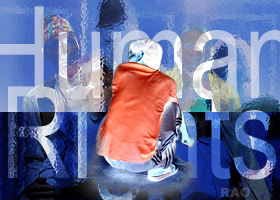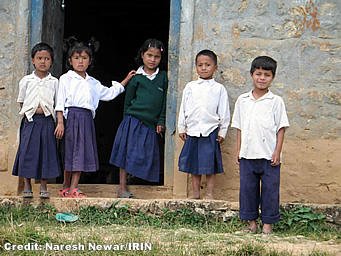|
Nepal
in Crisis 2006: Facts
|
|
Children
still living in fear of Maoist rebels
|
 |
BANKE,
11 Sep 2006 (IRIN)
Every
morning as 13-year-old Bimala Timilsina walks towards her Chandanath High
School in Jumla, nearly 800 km northwest of the Nepali capital, Kathmandu,
she is afraid that Maoist rebels will abduct her and force her to join
their movement.
 |
| "For
how long should we, children, live in fear and with insecurity like this?"
asked Timilsina, who recounted that the Maoists often came to her school
and organised Maoists' revolutionary programmes. They asked all students
to form youth Maoist groups to spread their ideology in the remote villages
and also to collect donations forcefully from the poor villagers, she said.
"They
take children by force from schools to some remote villages without letting
us inform our parents and then make us walk for days to attend their revolutionary
activities," said 14-year-old Bishnu Bahadur from Tatopani village in Jumla
district. |
|
The
young schoolboy was made to walk for three days to reach the Maoist camp
in the area but he managed to flee his captors. Despite urgent appeals
by local child rights' and human rights' groups not to engage children
in their political activities, the rebels have turned a deaf ear, observers
say.
After
nearly 10 years of armed rebellion against the Nepalese state, the Maoists
have for the past four months been involved in the peace process with the
new interim government of seven national parties to end the decade-long
violent conflict that has killed over 14,000 people in the Himalayan kingdom.
Since
April, the two sides have had a series of peace talks following the end
of the absolute rule of the Nepalese monarch, King Gyanendra, after a mass
uprising against him jointly led by the rebels and the seven main parties.
Child
rights advocacy groups in the country had hoped that the ongoing peace
process would provide a safe environment for children compared to the years
of conflict when over 400 children were killed and 1,000 more injured,
according to the Child Workers in Nepal (CWIN), a local child rights' group.
"But
even now, there is no protection and security for these innocent children
who are constantly threatened and intimidated by the Maoists," said activist
Saraswati Malla from the rights group, Insec.
Malla
explained that the members of the Maoist-affiliated All Nepal National
Students Union Revolutionary (ANNSU-R) visit schools along with the Maoist
militants in their combat uniforms and force students to form Maoist associations
in schools.
"The
students become members out of fear and they in turn have to increase members
in their associations and help the Maoists to collect donations in the
villages," said 15-year-old Sudan Kharel from Dang, a remote district lying
500 km west of Kathmandu.
But
the rebels reject such accusations saying that they never used children
for their political or military activities.
top
 |
| "We
are very sensitive about human rights and it is against our policy to involve
children in any sort of political activity. We will take action against
the cadres who have been involved in abductions or forceful participation
of children in any of our political programmes," explained Maoist leader
Anil Chettri in Kohalpur, Banke district, 600 km west of the capital.
"This
is all political propaganda by other parties to defame us. Where is the
evidence for such claims?" asked another leader, Purna Subedi. |
|
But
some rebels admitted that children were joining their programmes of their
own will and not through force. "We cannot stop the children who are impressed
with our ideology and interested in our party activities. They have also
their own rights and freedom to make their choices," said Maoist worker
Sunil.
However,
the students who had suffered at the hands of the Maoist workers said that
the rebels were not telling the truth. "The rebels often come to our schools
and disturb us in the middle of our classes. Many of my friends missed
their regular classes and were taken to the Maoist programmes even in the
middle of exams," said 14-year-old Madhaba Sharma.
Several
children who spoke to IRIN said that the rebels also set up their mobile
and temporary camps near school areas. Only a few weeks ago, the Maoists
had assembled over 3,000 students at Bahumukhi Campus in Surkhet, 700 km
west of Kathmandu, said 16-year-old student Laxmi Regmi.
top
Credit
IRIN 2006
Copyright
© UN Office for the Coordination of Humanitarian Affairs 2006
[
This report does not necessarily reflect the views of the United Nations]
Integrated
Regional Information Networks (IRIN), part of the UN Office for the Coordination
of Humanitarian Affairs (OCHA).

|





